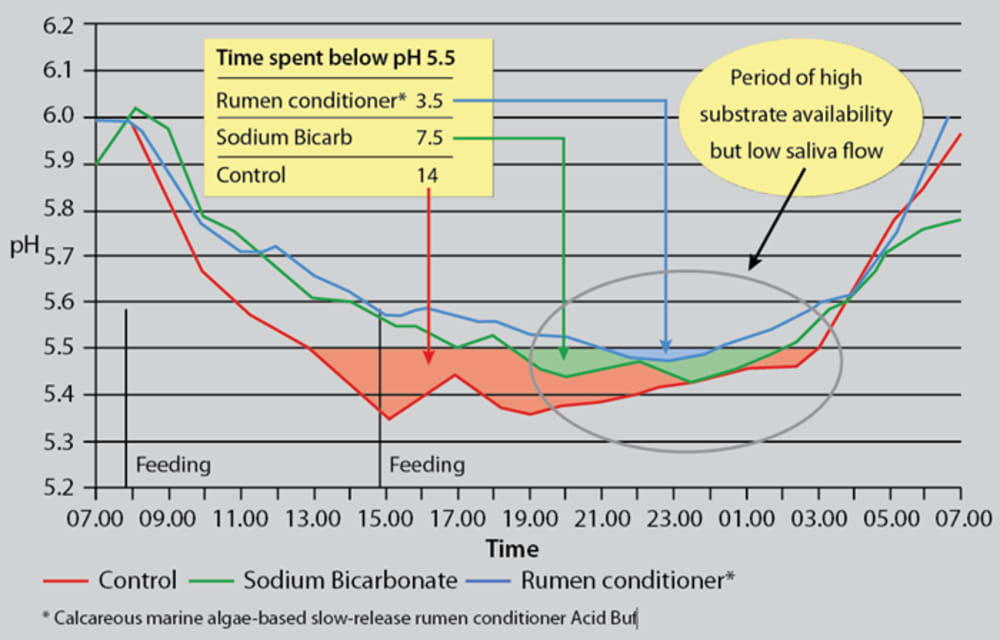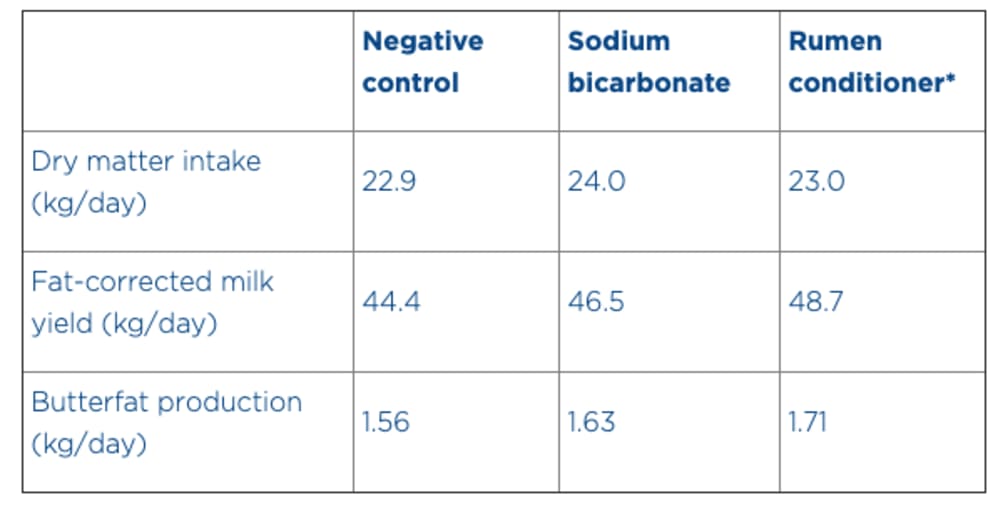Rumen buffering the key to improved feed efficiency, not just acidosis control
Published Sunday, 18th September 2016
Improving rumen function and feed efficiency can offer significant gains in milk from forage and overall dairy unit profitability, explains AB Vista’s Dr Derek McIlmoyle.
Compared to the major focus placed on feed efficiency by the pig and poultry sectors, the efficiency with which feed is converted into milk receives relatively little attention on most UK dairy farms. Although this is now starting change, rumen conditions – and rumen pH in particular – are still too often considered only when faced with a metabolic problem like acidosis.
“This misses some of the most important issues relating to rumen buffering and conditioning, which is a much more complex process than simply avoiding acidosis,” explains Dr Derek McIlmoyle, AB Vista’s technical director for GB and Ireland. “Even before acidosis becomes a problem, the efficiency with which the rumen ferments feed ingredients can be compromised if the rumen environment is unbalanced.
“The result is a loss of nutrients, below optimum performance and a lower margin over feed.”
Assessing acidosis risk
The risk of acidosis is highest when large volumes of rapidly fermented concentrates are fed, particularly if the ration is relatively low in digestible and structural fibre – both essential for good rumen function. However, the high level of energy density needed to maintain yields in excess of 30-40 litres/cow/day mean there is still a risk of acidosis even with a well-balanced ration.
“More importantly, if those rations are pushing the limits of what the rumen can withstand, even if avoiding sub-clinical acidosis, the chances are that rumen fermentation efficiency is already compromised,” adds Dr McIlmoyle. “This is where good rumen buffering really comes into its own, using specific rumen conditioners to improve feed efficiency as well as further reduce the risk of acidosis.”
Feed efficiency is also a topic that’s coming under increasing scrutiny globally as the competition between human and livestock feed use rises thanks to a growing worldwide population and increasing biofuel production. During a 2012 symposium organised by the Food and Agriculture Organisation (FAO) of the United Nations in Bangkok, for example, both the efficiency of the rumen and the types of feed used to sustain it were discussed.
Spotlight on efficiency
“In the past, the main focus in ruminant livestock has been on maintaining productive output and fertility, with little regard to the cost of any methane, urea and carbon dioxide generated in the rumen for no return,” Dr McIlmoyle continues. “This is changing, with the need to free up cereals and starch products for direct human consumption making the loss of nutrients through inefficient rumen fermentation just as important as the financial and environmental costs.
“These pressures may only just be surfacing, but they are sure to have an increasingly strong impact on the availability and cost of livestock feed materials in the future. It also highlights the need to make feed efficiency a priority going forward, and to continue doing so even when the pressure on margins has eased.”
Optimum rumen function occurs within a relatively narrow pH range, and whilst the negative effects of acidosis (low rumen pH) are widely recognised, it is less well known that a high rumen pH can also be detrimental. These more alkaline conditions (typically in excess of pH6.2) can encourage the proliferation of methanogenic microbes that will convert valuable dietary energy sources into methane, rather than the volatile fatty acids (VFAs) that can be absorbed and utilised by the cow.
Optimising rumen conditions
“Maximum VFA production occurs when the rumen is kept above pH 5.5, ideally as close to pH 6.0 as possible, and it is by minimising the time spent outside this range that efficiency gains are made when the rumen is well buffered,” states Dr McIlmoyle. “Traditional soluble buffers like sodium bicarbonate are still used by some, and are very cheap, but many farmers are now switching to slow-release rumen conditioners, which can be both more cost-effective and have a greater impact in the rumen.
“Both are capable of reducing the extent, rate and duration of rumen pH drop, as shown in Figure 1. However, the slow-release buffer is clearly far more effective in minimising the amount of time the rumen spends at low pH.
Figure 1 – Rumen pH in TMR-fed cows during a 24 hour period (Source: University of Stellenbosch, 2006)
“There also appear to be significant disadvantages to the way in which sodium bicarbonate exerts its effect on rumen pH,” he adds.
In a recent trial carried out at the University of Georgia using early lactation Holsteins milked three times per day, a high-starch diet was fed on its own, or with the addition of either a soluble buffer (sodium bicarbonate) or a slow-release rumen conditioner. Cows fed the diet containing sodium bicarbonate consumed on average 1 kg dry matter (DM) more than those fed the other diets, rising to 2kg DM/cow/day extra by the end of the ten week trial. However, in terms of milk yield, output failed to match that of the slow-release rumen conditioner-treated ration (see Table 1).
Table 1 – Comparison of rumen buffers in early lactation Holstein cows (Source: University of Georgia, 2012)
* Calcareous marine algae-based slow-release rumen conditioner Acid Buf
“The efficiency of the cows on the diet containing the slow-release rumen conditioner was clearly ahead of those on either the sodium bicarbonate ration or the control,” highlights Dr McIlmoyle. “This backs up a previous large-scale production trial involving 800 milking cows in Florida.
“Averaging 30 kg of milk at 3.8% butterfat, a switch from sodium bicarbonate to the slow-release rumen conditioner for a two month period improved feed efficiency by 5%, year on year, resulting in an almost doubling of the daily margin over feed.”
Sodium bicarbonate challenges
It appears that sodium bicarbonate, although effective in maintaining rumen pH and reducing the risk of acidosis, also has a negative impact on rumen fermentation efficiency. In fact, it’s been suggested that the mechanism by which sodium bicarbonate reduces acidosis risk involves increasing the rate of passage through the rumen, simply reducing the availability of ration ingredients for fermentation.
“If rapidly available starch, for example, is moved through the rumen faster, then clearly the potential for it to cause a build-up of the lactic acid responsible for acidosis is reduced,” Dr McIlmoyle adds. “Such a theory would also explain the increased DM and water intakes typically seen when sodium bicarbonate is fed, both of which would be driven by a faster rate of passage.
“Although the result of feeding sodium bicarbonate is generally an improvement in production compared to an untreated diet, the extra milk output is less than would be expected from the additional volume of feed consumed. The problem of acidosis might be avoided, but there’s a significant drop in feed efficiency caused by the higher rate of flow through the rumen, and a reduction in the margin over feed that could have been achieved.”
Recent results looking at faecal quality from grass-based diets in the UK found a greater level of long fibre particles when cows were fed sodium bicarbonate, confirming the reduction in fermentation efficiency. The mechanism by which sodium bicarbonate increases rate of passage is also becoming clear – rumen outflow rate is closely controlled to maintain carbon dioxide concentrations below certain limits, and sodium bicarbonate adds to that carbon dioxide level.
“What is clear is that rumen buffering and conditioning has an important role to play,” concludes Dr McIlmoyle. “So focus on feed efficiency, optimise the rumen environment and aim to maximise the return from this winter’s rations, rather than just avoid problems like acidosis.”
Latest news
Stay ahead with the latest news, ideas and events.

Online Feed Fibre Calculator
Calculate the percentage of dietary fibre in your feed
Our calculator is designed for nutritionists and uses averages of global raw materials to calculate the dietary fibre content (plus other more in-depth fibre parameters) of finished animal feed. These parameters are available within AB Vista’s Dietary Fibre analysis service (part of our NIR service).
Sign up for AB Vista news
A regular summary of our key stories sent straight to your inbox.
SUBSCRIBE© AB Vista. All rights reserved 2025
Website T&Cs Privacy & Cookie Policy Terms & Conditions of Sale University IDC policy Speak Up Policy


























